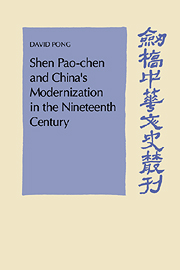Book contents
- Frontmatter
- Contents
- List of maps, tables, and figure
- Acknowledgements
- A note on spelling
- Abbreviations used in the notes
- Introduction
- 1 Early years
- 2 Local official in Kiangsi, 1856–1859
- 3 Governor of Kiangsi, 1862–1865
- 4 First encounters with foreigners
- 5 Director-general of the Foochow Navy Yard
- 6 The Foochow Navy Yard: early developments, 1866—1867
- 7 The Foochow Navy Yard: administration and personnel
- 8 The Foochow Navy Yard: building and training programmes
- 9 The Foochow Navy Yard: financial crises
- 10 The next steps in defence modernization: Ma-wei and beyond
- 11 Towards a plan for self-strengthening
- Conclusion
- Glossary of Chinese characters
- Bibliography
- Index
10 - The next steps in defence modernization: Ma-wei and beyond
Published online by Cambridge University Press: 22 September 2009
- Frontmatter
- Contents
- List of maps, tables, and figure
- Acknowledgements
- A note on spelling
- Abbreviations used in the notes
- Introduction
- 1 Early years
- 2 Local official in Kiangsi, 1856–1859
- 3 Governor of Kiangsi, 1862–1865
- 4 First encounters with foreigners
- 5 Director-general of the Foochow Navy Yard
- 6 The Foochow Navy Yard: early developments, 1866—1867
- 7 The Foochow Navy Yard: administration and personnel
- 8 The Foochow Navy Yard: building and training programmes
- 9 The Foochow Navy Yard: financial crises
- 10 The next steps in defence modernization: Ma-wei and beyond
- 11 Towards a plan for self-strengthening
- Conclusion
- Glossary of Chinese characters
- Bibliography
- Index
Summary
When Tso Tsung-t'ang founded the Navy Yard, his plan seemed grandiose, perhaps even impossible to achieve. In time, however, perceptions changed. Even as the Navy Yard came under heavy criticism in 1872, Shen Pao-chen felt positive about what had already been accomplished and argued that more, rather than less, should be done to modernize the country's defence. He then proposed the institution of a new civil service examination on mathematics, advanced studies in Europe for the students, and a programme for interprovincial naval training. Later, plans for building more advanced vessels were made. In his mind, Tso's original plan now represented the foundation, not the limits, of China's defence modernization.
It is hard to say when Shen began to see the Navy Yard as a germinal modernizing enterprise. It is clear to us that the Navy Yard, as a foreign implant, could not be efficiently run by traditional means, and as it expanded, it would demand changes in the milieu in which it operated. But it cannot be assumed that the nature of yang-wu enterprises would itself bring about a new understanding of their seminal role in China's modernization. Managers of some modern arsenals appeared not to have acquired such an understanding. Shen, however, demonstrated a degree of awareness the day he took office as he accepted the inevitability of the Navy Yard's future expansion and the need to catch up with an everchanging technology.
- Type
- Chapter
- Information
- Publisher: Cambridge University PressPrint publication year: 1994



